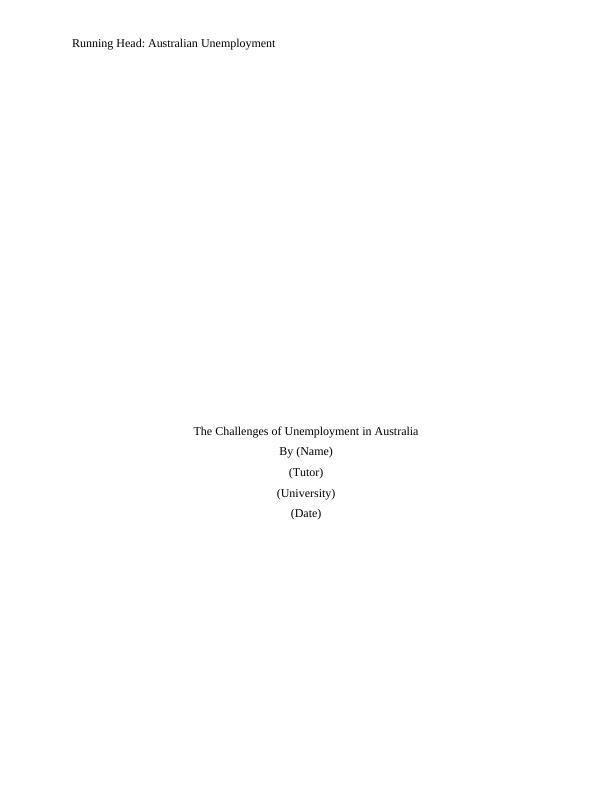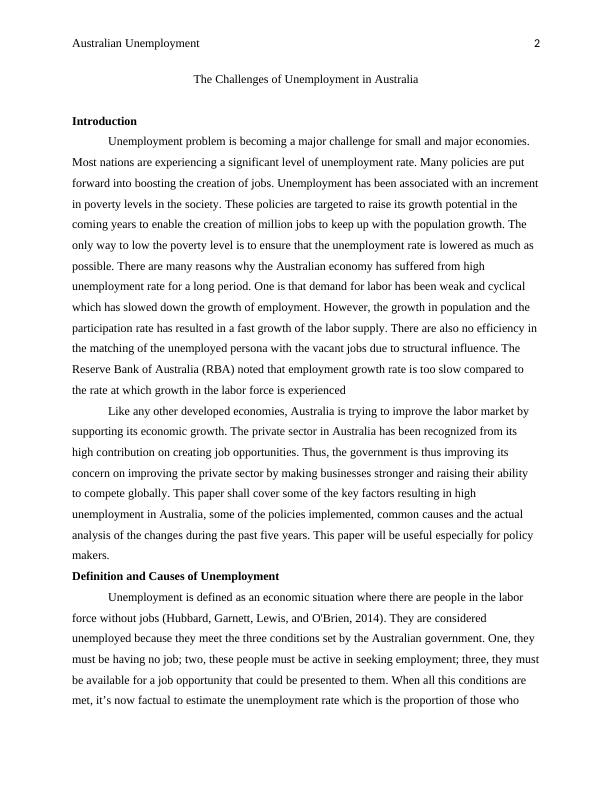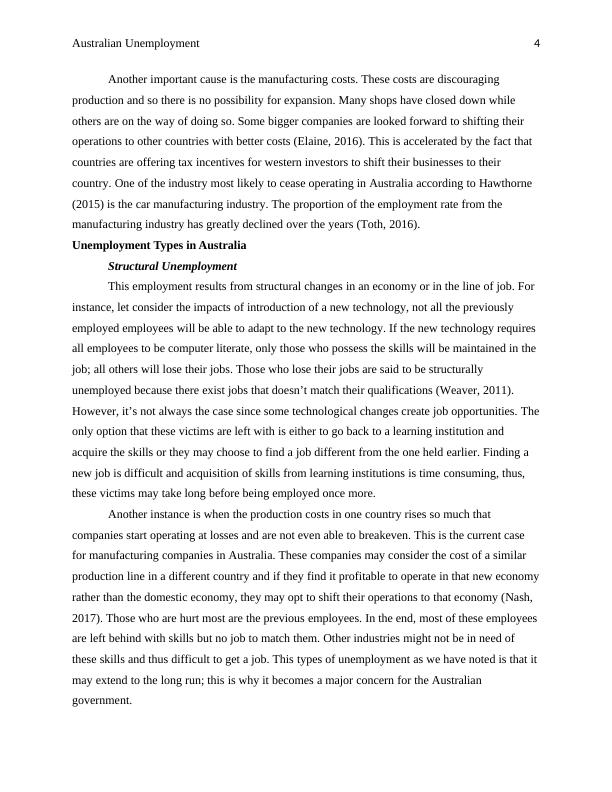The Challenges of Unemployment in Australia
11 Pages3605 Words41 Views
Added on 2021-06-17
The Challenges of Unemployment in Australia
Added on 2021-06-17
ShareRelated Documents
Running Head: Australian UnemploymentThe Challenges of Unemployment in AustraliaBy (Name)(Tutor)(University)(Date)

Australian Unemployment2The Challenges of Unemployment in AustraliaIntroduction Unemployment problem is becoming a major challenge for small and major economies. Most nations are experiencing a significant level of unemployment rate. Many policies are put forward into boosting the creation of jobs. Unemployment has been associated with an incrementin poverty levels in the society. These policies are targeted to raise its growth potential in the coming years to enable the creation of million jobs to keep up with the population growth. The only way to low the poverty level is to ensure that the unemployment rate is lowered as much as possible. There are many reasons why the Australian economy has suffered from high unemployment rate for a long period. One is that demand for labor has been weak and cyclical which has slowed down the growth of employment. However, the growth in population and the participation rate has resulted in a fast growth of the labor supply. There are also no efficiency inthe matching of the unemployed persona with the vacant jobs due to structural influence. The Reserve Bank of Australia (RBA) noted that employment growth rate is too slow compared to the rate at which growth in the labor force is experiencedLike any other developed economies, Australia is trying to improve the labor market by supporting its economic growth. The private sector in Australia has been recognized from its high contribution on creating job opportunities. Thus, the government is thus improving its concern on improving the private sector by making businesses stronger and raising their ability to compete globally. This paper shall cover some of the key factors resulting in high unemployment in Australia, some of the policies implemented, common causes and the actual analysis of the changes during the past five years. This paper will be useful especially for policy makers.Definition and Causes of UnemploymentUnemployment is defined as an economic situation where there are people in the labor force without jobs (Hubbard, Garnett, Lewis, and O'Brien, 2014). They are considered unemployed because they meet the three conditions set by the Australian government. One, they must be having no job; two, these people must be active in seeking employment; three, they mustbe available for a job opportunity that could be presented to them. When all this conditions are met, it’s now factual to estimate the unemployment rate which is the proportion of those who

Australian Unemployment3have met the conditions of being unemployed to the economy’s labor force. The conditions for unemployment excludes many people from being considered unemployment even if they have nojob.There are many factors that drives the high unemployment rate. One of them is the union pressures; the unions are distorting the market for labor where wages are determined by demand and supply. The equilibrium level cannot be achieved in this market because, the wage rates payable are above the equilibrium wage. At a lower wage rate, employers would be willing to add into their workforce some more labor and the unemployment rate would fall. However, the case for Australia is different, the high wages has led to businesses lowering their workforce as illustrated below.Fig: Equilibrium in the Australian labor market Wage RateSupply WuWeDemand Q1 Qe Q2 Capacity (Q)If the market was on its own, the equilibrium wage is We and the capacity is Qe. However, due to monopoly pressures, the wage rate is fixed above We at wage Wu. At the higher wage Wu, businesses demand Q1 workers; but this high wage attracts many people to the labor force causing an oversupply of labor equal to Q2 – Q1. Q2 number of persons are willing to supply labor at wage Wu. The equilibrium is completely distorted.

Australian Unemployment4Another important cause is the manufacturing costs. These costs are discouraging production and so there is no possibility for expansion. Many shops have closed down while others are on the way of doing so. Some bigger companies are looked forward to shifting their operations to other countries with better costs (Elaine, 2016). This is accelerated by the fact that countries are offering tax incentives for western investors to shift their businesses to their country. One of the industry most likely to cease operating in Australia according to Hawthorne (2015) is the car manufacturing industry. The proportion of the employment rate from the manufacturing industry has greatly declined over the years (Toth, 2016).Unemployment Types in AustraliaStructural UnemploymentThis employment results from structural changes in an economy or in the line of job. For instance, let consider the impacts of introduction of a new technology, not all the previously employed employees will be able to adapt to the new technology. If the new technology requires all employees to be computer literate, only those who possess the skills will be maintained in the job; all others will lose their jobs. Those who lose their jobs are said to be structurally unemployed because there exist jobs that doesn’t match their qualifications (Weaver, 2011). However, it’s not always the case since some technological changes create job opportunities. Theonly option that these victims are left with is either to go back to a learning institution and acquire the skills or they may choose to find a job different from the one held earlier. Finding a new job is difficult and acquisition of skills from learning institutions is time consuming, thus, these victims may take long before being employed once more. Another instance is when the production costs in one country rises so much that companies start operating at losses and are not even able to breakeven. This is the current case for manufacturing companies in Australia. These companies may consider the cost of a similar production line in a different country and if they find it profitable to operate in that new economyrather than the domestic economy, they may opt to shift their operations to that economy (Nash, 2017). Those who are hurt most are the previous employees. In the end, most of these employeesare left behind with skills but no job to match them. Other industries might not be in need of these skills and thus difficult to get a job. This types of unemployment as we have noted is that itmay extend to the long run; this is why it becomes a major concern for the Australian government.

End of preview
Want to access all the pages? Upload your documents or become a member.
Related Documents
Causes and Policies to Reduce Unemployment in Australialg...
|10
|2348
|178
Unemployment Issues Assignment PDFlg...
|12
|3235
|79
Analyse Unemployment in Australia and Indialg...
|7
|1534
|235
Unemployment in Australia: Effects on the Economy and Government Policieslg...
|15
|3581
|422
Unemployment and Wages in the Labor Market - Economicslg...
|5
|971
|384
Impact of Low Wages on Economic Growth in Australialg...
|7
|1961
|78
